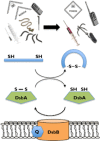Targeting virulence not viability in the search for future antibacterials
- PMID: 24552512
- PMCID: PMC4309627
- DOI: 10.1111/bcp.12356
Targeting virulence not viability in the search for future antibacterials
Abstract
New antibacterials need new approaches to overcome the problem of rapid antibiotic resistance. Here we review the development of potential new antibacterial drugs that do not kill bacteria or inhibit their growth, but combat disease instead by targeting bacterial virulence.
Keywords: antibacterial; antivirulence; bacterial infection; pilicide; quorum sensing.
© 2014 The British Pharmacological Society.
Figures



References
-
- Infectious Disease Society of America. Bad Bugs, No Drugs: As Antibiotic Discovery Stagnates, A Public Health Crisis Brews. Alexandria, VA: Infectious Disease Society of America; 2004.
-
- Zucca M, Scutera S, Savoia D. New antimicrobial frontiers. Mini Rev Med Chem. 2011;11:888–900. - PubMed
-
- Escaich S. Novel agents to inhibit microbial virulence and pathogenicity. Expert Opin Ther Pat. 2010;20:1401–1418. - PubMed
-
- Suree N, Jung ME, Clubb RT. Recent advances towards new anti-infective agents that inhibit cell surface protein anchoring in Staphylococcus aureus and other gram-positive pathogens. Mini Rev Med Chem. 2007;7:991–1000. - PubMed
Publication types
MeSH terms
Substances
LinkOut - more resources
Full Text Sources
Other Literature Sources
Medical

